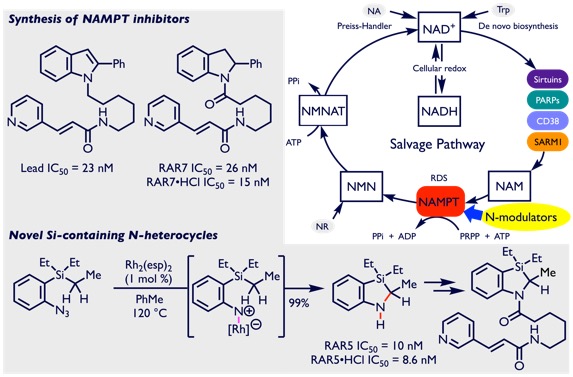Medicinal Chemistry Translational Projects
Our research group is also focused on the synthesis of bioactive N-heterocyclic chemical probes to potentiate biological processes critical in diseases that affect human health.
PULMONARY ARTERIAL HYPERTENSION — NIH NHLBI VITA HHSN2680170006C

Figure taken from www.pah-info.com
Pulmonary arterial hypertension (PAH) is a debilitating disease that involves remodeling of the arterial blood vessels of the lung, which culminates in heart failure and death. There is no cure for this fatal disease; current treatment targets symptomatic vasoconstriction by producing pulmonary vasodilation rather than addressing the cellular dysfunction—increased cell proliferation and apoptosis resistance of pulmonary endothelial and smooth muscle cells—that triggers pulmonary vascular remodeling. Nicotinamide phosphoribosyltransferase (NAMPT) is a multifunctional protein that regulates nicotinamide adenine dinucleotide (NAD) levels and inhibits apoptosis. Patients with idiopathic PAH were found by our collaborator, Dr. Roberto Machado (IU Medicine), to have a significant increase in plasma NAMPT and increased NAMPT expression in pulmonary vasculature within remodeled vessels in comparison to control patients.4 We have synthesized a series of novel nanomolar NAMPT inhibitors that inhibit cell proliferation or pulmonary arterial endothelial cells (PAECs) and pulmonary arterial smooth muscle cells (PASMCS) and reverse the vascular remodeling in pre-clinical PAH animal models (MCT- and hypoxia-SUGEN rats). In 2018, Machado and Driver established a start-up company, Drax Therapeutics, Inc., in Indiana to advance this technology.

NAMPT inhibitors as potential therapeutics for PAH.
SLEEP APNEA — NIH UH2HL123610

Figure reproduced from Smith, K. A.; Yuan, J. X.-J. Am. J. Physiol. Cell Physiol. 2012, 303, C911. link
The pauses in breathing that characterize sleep apnea leads to a build up of carbon dioxide in the blood stream. The carotid body is the critical sensor of arterial blood oxygen, and enhanced carotid body reflexes have been shown to play an important role in sleep-disordered breathing, which suggest that it is a potential therapeutic target to treat this condition. Recently, research into function of the carotid body has suggested that H2S is required for hypoxic sensing.1,2 H2S is produced by several enzymes including cystathionine-γ-lyase and cystathionine-β-synthase. As part of a multi-institutional collaboration between the University of Chicago, IITRI, UIC’s Department of Medicinal Chemistry and Pharmacognosy and UIC’s Department of Chemistry, our laboratory has designed and synthesized a variety of potential small molecule inhibitors of cystathionine-γ-lyase to identify a small molecule chemotherapeutic for the treatment of sleep apnea.
Regulatorial Role of H2S

Figure reproduced from Lin, V. S.; Chen, W.; Xian, M.; Chang, C. J. Chem. Soc. Rev. 2015, 44, 4596. link
Recently, hydrogen sulfide has emerged as an important gasotransmitter that regulates a diverse range of biological processes including vasodilation, neurotransmission and immune response. Its role to potentiate these physiological functions has inspired chemists to design and synthesize sensors for its detection. The challenge to detect H2S is its low concentration in the blood (<1μM) and how to distinguish it from other sulfides. Together with our collaborators Professors Larry Miller (UIC Chemistry), Terry Moore (UIC Pharmaceutical Sciences) and Greg Thatcher (University of Arizona), we leveraged the rapid hydrogen sulfide reduction of azides to design and synthesize H2S sensors with improved sensitivity and selectivity. We are also interested in synthesizing chemical probes to release H2S to observe its effect on enzyme activity as well as its ability to change cellular morphology with Professor David Eddington (UIC Engineering).
ACUTE LUNG INJURY

Acute lung injury is a continuum of clinical and radiographic changes affecting the lungs that is characterized by acute onset severe hypoxaemia. One of the consequences of acute lung injury is the breakdown of the endothelial cell layer of the pulmonary vasculature, which is the semipermeable barrier between the blood and the interstitial of the lung. This breakdown causes fluid and mortality seen with acute lung injuries. Currently, there are no therapies that prevent or reverse vascular barrier leak. Recently, in vitro and in vivo studies by Garcia and co-workers suggest that sphigosine-1-phosphate receptors could function as barrier protective agents to maintain the vascular barrier integrity. Together with Professor Greg Thatcher, Steve Dudek and Vishna Natarjan we synthesized S1P ligands to investigate their effect in preventing vascular barrier leak.
BIOFILM FORMATION

Figure reproduced from Federle, M. J.; Jimenez, J. C. Front. Cell. Infect. Microbiol. 2014, 4. link
In collaboration with Professor Michael Federle, the Anderson group and our group designed and synthesized chemical probes to investigate the mechanism of how Streptocussus pyogenies bacteria coordinate gene expression using cell-to-cell communication. This communication can control whether a bacteria forms a biofilm or becomes virulent. The Federle group has identified and characterized new quorum sensing pathways centered on the Rgg family of proteins. These proteins act as both cytoplasmic receptors and transcription regulators. Our goal is that our chemical probes will provide insight into the role of the quorum sensing network in controlling the virulence factors that contribute to disease.